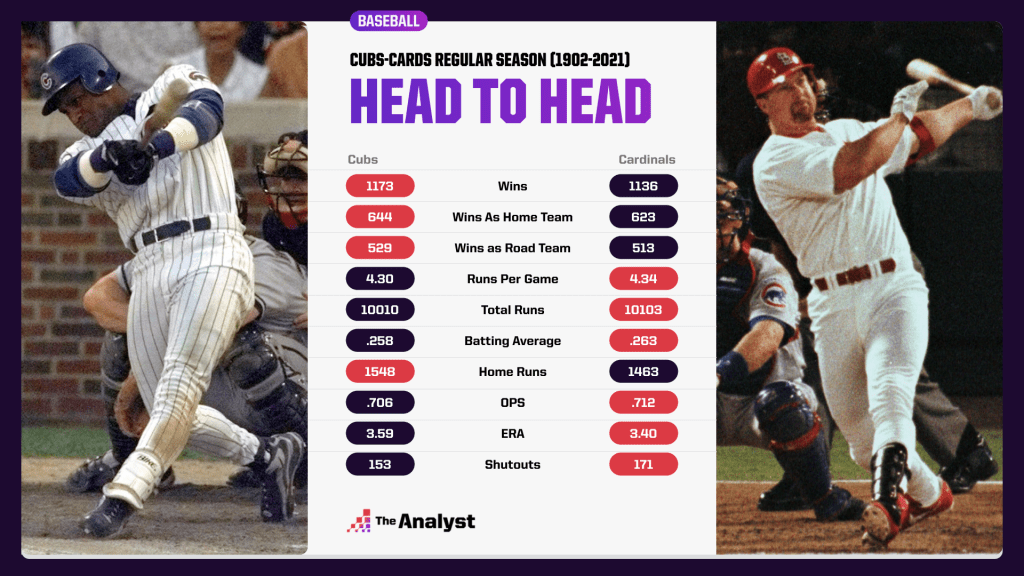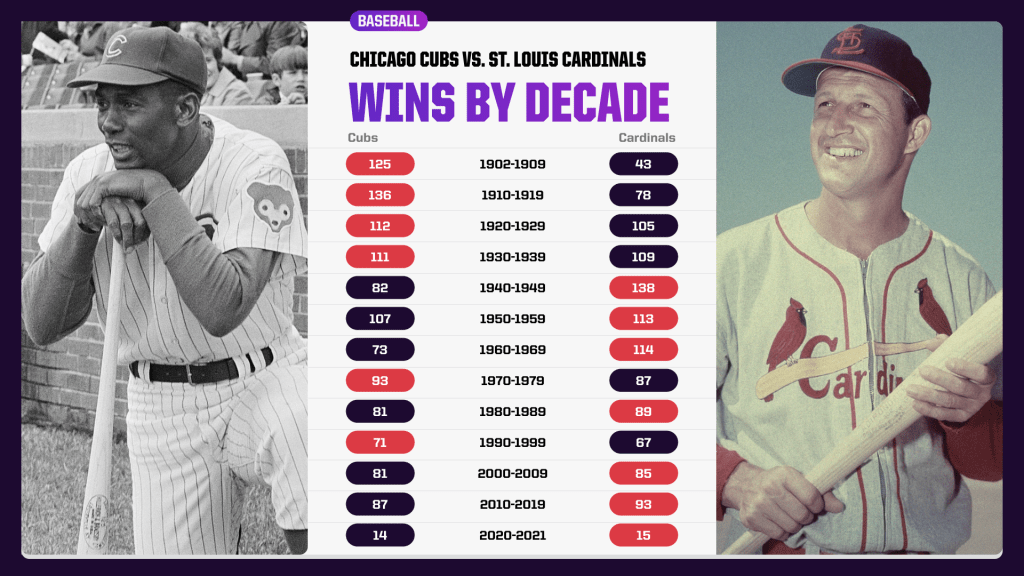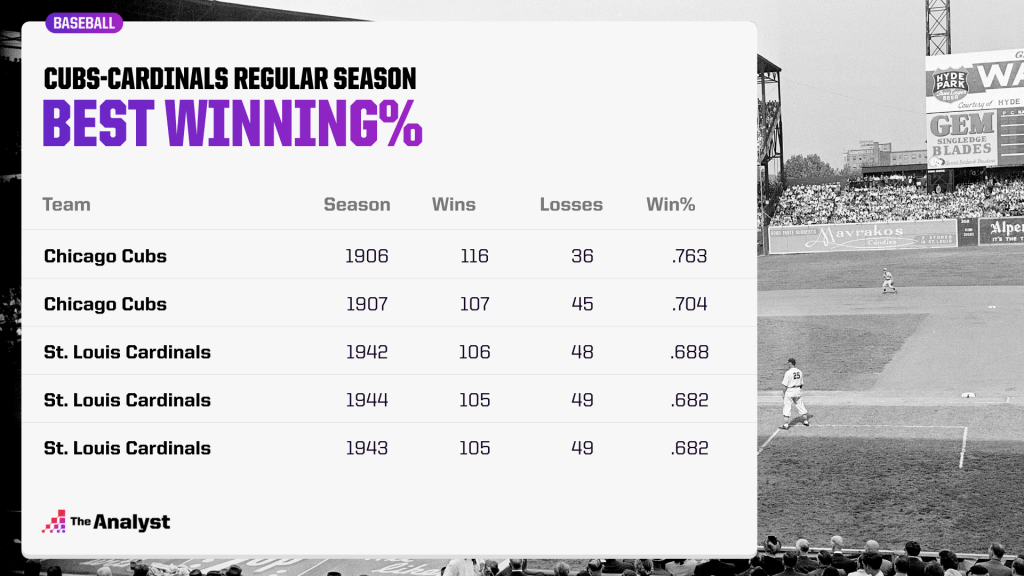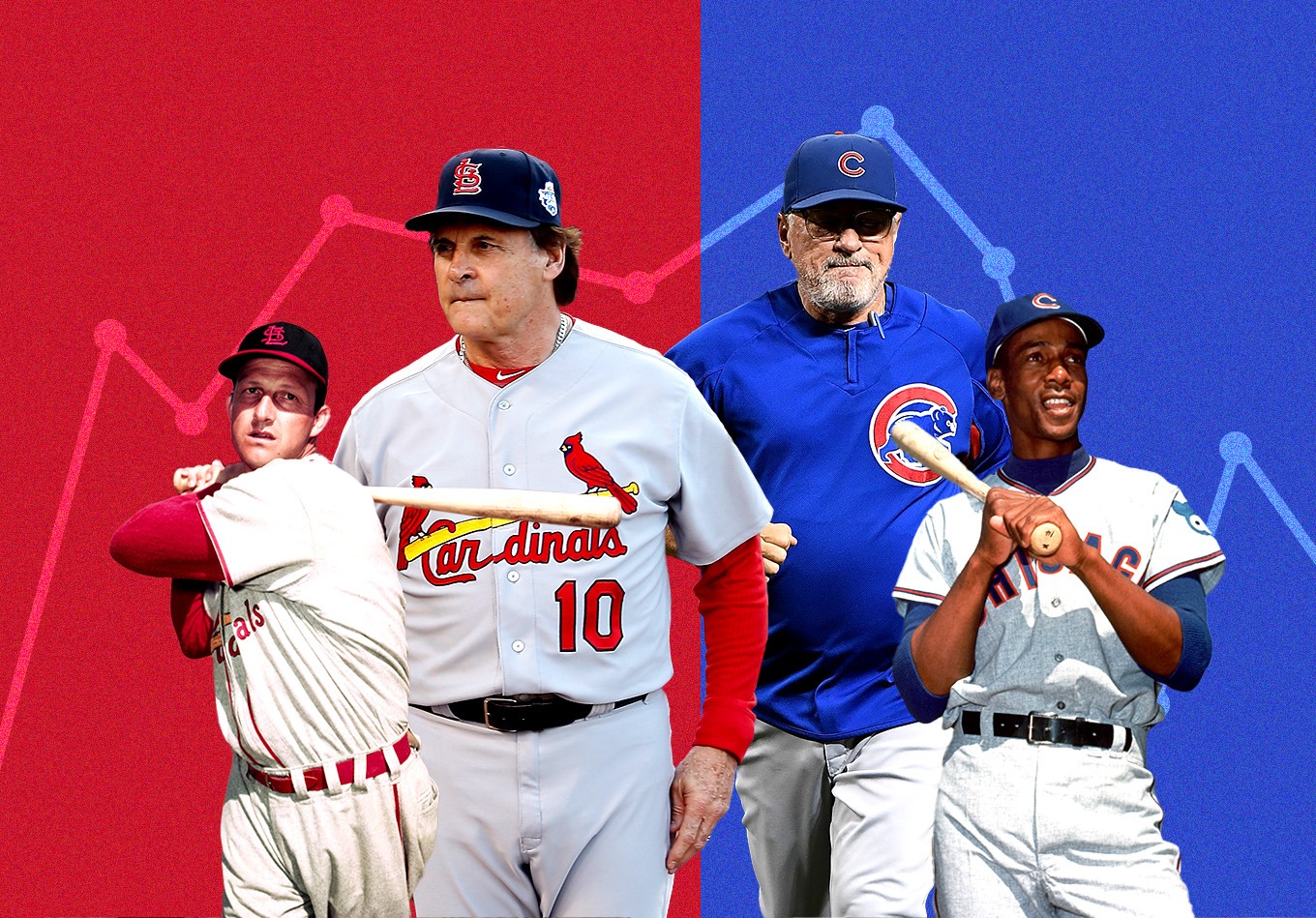The Cubs-Cardinals rivalry enters its 131st season this week. Telling the story comprehensively would take volumes, so we took a crack at showing it with fewer words and more data viz.
Perhaps it had something to do with an economic trade rivalry between the cities in the 1800s as Jon David Cash speculated in his book “Before They Were Cardinals” or the St. Louis outrage over Chicago reversing the flow of its foul, polluted river in 1900.
Sure, the feud between Chicago and St. Louis extends beyond baseball. But a rivalry on the diamond that started with its first meeting on April 12, 1892 has long been considered one of the fiercest of all North American professional sports.
Along the way, Tinkers to Evers to Chance, the Gashouse Gang, the Lou Brock trade, the 1974 brawl, Harry Caray and Jack Buck, The Sandberg Game, the Sosa-McGwire home run chase, Dusty Baker vs. Tony La Russa, the Cardinals’ Way before the Cubs’ Way and the videoboard home run have been prominently featured.
The announcers have made their allegiances clear when the time has come to do so. The players haven’t much liked each other through the years and the fans certainly have never liked each other once the game is on despite often being friends, family members and co-workers.
That hasn’t changed as the rivalry enters its 131st season with the Cardinals seeking their fourth straight trip to the postseason and the Cubs in rebuilding mode following one of the best stretches in franchise history.
Like most rivalries that have stood the test of time, both sides have dominated in spurts before the pendulum inevitably swung back the other direction. Where it has ended up is somewhere in the middle, with just 37 wins and 93 runs separating the two franchises since 1902.
This season, we’ve done a series called The Viz, in which we let data visualizations and tables do much of the talking. The New York Yankees and Boston Red Sox came first in April, followed by the San Francisco Giants and Los Angeles Dodgers last month.
And now, the Cubs and the Cardinals.
The Regular Season
We mentioned that the first meeting was on April 12, 1892, so why are we looking at what was once known as the Route 66 rivalry from 1902 on?
To begin with, 1901 is generally considered the start of “modern baseball.” And the Cubs-Cardinals rivalry in name actually began in 1902 when the Chicago Daily News became the first outlet to use “Cubs” as a nickname for the team that was then known as the Chicago Orphans.
The name Orphans was officially dropped the following year. The St. Louis Perfectos had become the Cardinals three years earlier.
Those who follow the 1-55 rivalry might be surprised to learn that the Cubs hold a 1,173-1,136 advantage since that 1902 campaign. But break the tale of the tape down further, and you’ll see the Cardinals hold advantages in many of the individual categories.

There have also been 17 regular-season ties between the two clubs, with the last one taking place during the strike-shortened 1981 season in which the Cardinals won the NL East and the Cubs ended up the worst team in the National League.
But the early years, of course, were ruled by the Cubs, who won back-to-back titles while appearing in three straight World Series from 1906-08. They went a ridiculous 271-133 – including a 143-62 mark at home – against the rival Redbirds between the 1902-20 seasons.
Frank Chance of Tinker-to-Evers-to-Chance fame was a thorn in the Cardinals’ side with a .331 batting average in his 152 games in the series between 1902-11. Wildfire Schulte loved to play St. Louis, hitting .277 with franchise highs of 15 home runs (homers weren’t really a thing yet), 47 doubles and 22 triples against them from 1905-16.
But things started to change as the Cardinals rose to prominence in the 1920s. Between 1920-50, St. Louis went 364-315 against its neighbor to the north while establishing that it was no longer the tomato can in the rivalry.
Hall of Famer Rogers Hornsby is perhaps the best player to play on both sides (Cardinals 1915-26/1933-37, Cubs 1929-32). He’s the Cubs’ all-time leading hitter (.384 in 53 meetings) against the Cardinals and the Cards’ all-time leading hitter versus the Cubs (.364 in 226).
For Chicago, however, there were dark times after losing in Game 7 of the 1945 World Series to the Detroit Tigers. From 1946-83, the Cubs failed to advance to the postseason while only finishing as high as second three times.
They also went 340-398 against the Cardinals over that span.

A big reason the clubs headed in different directions in the 1960s was the trade that was consummated on June 15, 1964. The six-player deal sent Lou Brock to St. Louis and Ernie Broglio to Chicago.
Brock, who was in his fourth season at the time, went on to become a Hall of Famer, finishing with 3,023 career hits and swiping more bases (938) than anyone in baseball history until Ricky Henderson broke that mark in 1991. He also crushed his former team, batting .334 with 64 doubles and an .856 OPS – his highest numbers against any opponent – in 256 career meetings.
Broglio went 7-19 with a 5.40 ERA in 59 games for Cubs while battling arm troubles. The deal now simply known as “the Lou Brock trade” has become synonymous with the “lovable losers” label that the Cubs earned during this era that extended their championship drought to epic proportions.
For the Cardinals, Brock and flamethrower Bob Gibson keyed a march to three World Series appearances between 1964-68. And Gibson’s performance in ’68 when he went 22-9 with a 1.12 ERA and won both the NL MVP and Cy Young Award played a major role in MLB raising the mound the following season.
The right-hander also has the most strikeouts versus Chicago by a Cardinals hurler with 338, well ahead Adam Wainwright’s 242.

The Cubs finally broke through and returned to the playoffs in 1984. And the biggest moment of this still-celebrated season came against the Cardinals when Ryne Sandberg, still relatively unknown at that point, hit game-tying home runs in the ninth and 10th innings off former Cubs closer Bruce Sutter on a national television broadcast.
It became simply known as “The Sandberg Game” because it put the future Hall-of-Fame second baseman – and the ’84 Cubs – on the map.
Brock had helped bring back the alure of the stolen base, along with the success of the speedy Oakland A’s in the 1970s and the arrival of Astroturf in large ballparks. The Cardinals embraced this faster game on the turf in the ’80s when Vince Coleman stole 110, 107 and 109 bases from ’85-87. St. Louis swiped 314 bases in ’85 – the fourth most in a single season between 1902-2021 – and captured one of its three NL pennants during the decade.
The rivalry returned to the national spotlight in 1998 when super sluggers Mark McGwire and Sammy Sosa went toe-to-toe in a race to break Roger Maris’ single-season home run record. McGwire, of course, broke the record with his 62nd homer against Chicago in early September.
McGwire won the battle with 70 to Sosa’s 66, but Sosa had the last laugh as he won the NL MVP and the Cubs returned to the playoffs for the first time in nine years. Sosa’s 40 home runs against the Cardinals are the second most by a Cub in the rivalry next to Hall of Famer Ernie Banks’ 64 between 1953-71.
Though the Cubs appeared as though they would take control of the division after winning it in 2003, the Cardinals returned to the top in ’04, ’05 and ’06. Similarly, the Cubs won two straight division titles for only the second time in franchise history in ’16 and ’17 and won 95 games in ’18, but the Cardinals reclaimed the NL Central crown in ’19 and have qualified for the postseason the past three years heading into the 2022 series.
There have been six double-digit winning streaks in the rivalry, and surprisingly, the Cubs own five of them (though the most recent took place in 1978). Chicago also owns the longest run in the series at 16, which came during its reign in the early 1900s. The 1906 Cubs have the best winning percentage (116-36, .763) in MLB history during the modern era.
In the dropdown below, we’re looking at each team’s season-by-season numbers, then comparing them to a 10-year moving average for each metric. The seasons in which they stray drastically from those rolling averages are highlighted.
And remember some of those seasons – like 1994, 1995 and 2020 – had abbreviated schedules, so the season totals will naturally be lower.
Another way to visualize this is to plot runs per game and ERA for each team, which shows us the most dominant teams in the last 25 years.
The Managers
Believe it or not, the previously mentioned Chance holds the Cubs’ top winning percentage (eliminating ties) after serving as a player-manager from 1905-12. Of course, Joe Maddon is second on this list, having helped end the infamous championship drought and the other best stretch in the history of the franchise.
Billy Southworth, who played for the Cardinals in 1926, ’27 and ’29 before managing the team in ‘’29 and then again during their impressive stretch from 1940-45, owns the best winning percentage in St. Louis. We’d be remiss if we didn’t mention Branch Rickey, who managed the team from 1919-25, built the Gashouse Gang roster, started the first farm system and later, of course, signed Jackie Robinson while with the Brooklyn Dodgers.
Joe Torre also managed the Redbirds from 1990-95 before guiding the New York Yankees to four titles and a 76-47 record in the postseason between 1996-2007. But St. Louis ended up OK with Tony La Russa, who led the club to a pair of World Series titles and a .543 postseason winning percentage.
Things weren’t so friendly in the rivalry once Dusty Baker took over as Cubs manager in 2003. Baker and La Russa, who had been involved in a shouting match and both were fined in the 2002 NL Championship Series when Baker was managing the San Francisco Giants, continued their feud when the Cubs sought to knock the three-time defending division champions from their perch.
After the managers were caught on TV screaming at each other from the dugouts on Sept. 3, Baker told the Chicago Tribune: “I’ve heard Tony say things before. As far as I’m concerned, tricks are for kids, and I don’t take kindly to threats.”
But those were far from the ugliest moments in the rivalry’s history. That arguably may have been in 1974 when Bill Madlock and Al Hrabosky engaged in some gamesmanship before home plate umpire Shag Crawford ordered Hrabosky to pitch.
Crawford then called strike one on Madlock, who wasn’t yet in the batter’s box. Cubs manager Jim Marshall, who guided the team to a .445 winning percentage between 1974-76, came out to argue at home plate as Hrabosky continued to pitch and an all-out melee ensued.
The Playoffs
While the total regular-season tally between the Cubs and Cardinals is fairly even, the playoffs have been a one-sided affair.
The Cardinals have piled 134 postseason wins since 1903 – second only to the mighty New York Yankees – while the Cubs have 47. That included a stretch in which the club went 18-50 – and at one point lost nine straight playoff games – between Oct. 17, 1910 and Oct. 4, 2008. But, as has often been said about the Cubs, anyone can have a bad century.
However, there is one part of the playoff debate in which Cubs fans can boast – head to head. For teams in the same league, there wasn’t a chance for rivals to meet in the postseason until 1969. And for those in the same division, it wasn’t possible until the wild-card era.
That, coupled with the Cubs’ limited number of appearances, means these teams didn’t meet in the postseason until the 2015 NL Division Series. And after John Lackey shut down his future teammates in Game 1, Chicago won three straight to advance to its first NLCS since 2003.
In Game 4, Kyle Schwarber provided perhaps the most memorable moment when he hit a home run off Cardinals left-hander Kevin Siegrist that landed on top of the Wrigley Field videoboard in right field. The ball was later placed inside a plexiglass case by the Cubs and returned to where it landed.
Chicago made the playoffs in four straight years and five of six between 2015-20 for the first time in franchise history. They’ve since embarked on another rebuild while the Cardinals have made the playoffs in three straight years.
The World Series
After the Cubs got off to a fast start with the first two World Series titles between these rivals, the Cardinals won the next 11 while the Cubs were busy wallowing in the longest championship drought in the history of North American sports between 1909-2015.
Yep, the franchise that started out as a doormat for its rivals grew up to become the most accomplished team in National League history and the second-biggest powerhouse in all of baseball history.
The Cardinals’ 11 titles and 19 World Series appearances are, again, second only to the Yankees.
Though the Cubs continued to have success in the 1920s, reaching the World Series five times between 1929-45 (of course, losing them all), the Cards won it all six times in nine trips to Fall Classic between 1926-46.
Led by 30-game winner Dizzy Dean, the Gashouse Gang won three NL pennants and two World Series titles between 1930-34. The Cards won three more championships during the ’40s behind three-time MVP Stan Musial, who has the most home runs (67) by a Cardinal in this series.
St. Louis captured two more crowns in ’64 and ’67 before speed, pitching and defense carried the club to three World Series appearances in the ’80s.
After getting swept in the 2004 Fall Classic in their first appearance since 1987, the Cardinals won it all in 2006. Five years later, David Freese put together a legendary postseason performance for the ages during another magical run to title No. 11.
With the Texas Rangers one strike away from winning it all, Freese hit a two-run triple to send Game 6 into extra innings before hitting a walk-off home run to force a deciding game. He became the sixth player to win the LCS and World Series MVP awards in the same year.
But back to the Cubs roughly 70 years later…After stunning St. Louis in the 2015 NLDS, they finally broke the Billy Goat Curse a year later by storming back from a 3-1 series deficit to beat Cleveland in the World Series.
Also, pigs began to fly, and hell froze over.
So make sure to be nice to your friends, family members and co-workers rooting for the other side now, because one of the most bitter regional battles in North American professional sports is about to add another chapter.
Research support provided by Michael Donovan.
Enjoy this? Subscribe to our mailing list to receive exclusive weekly content.
